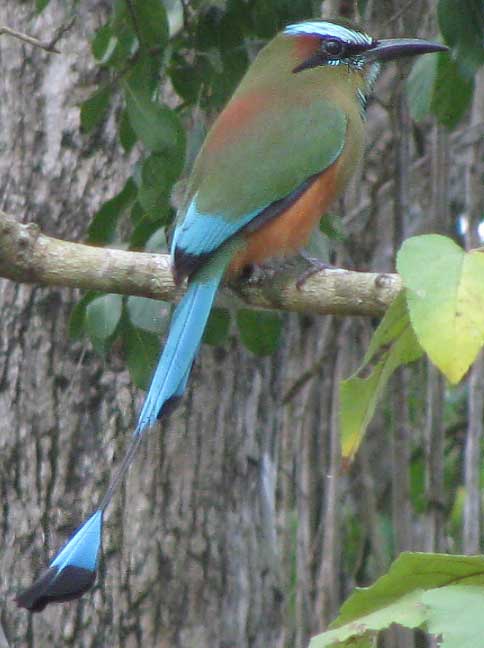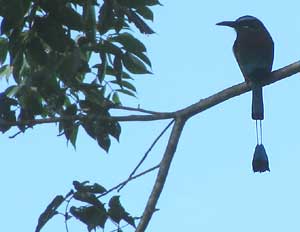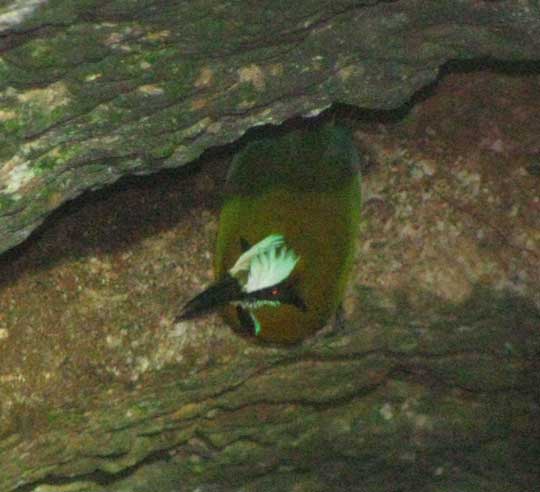Excerpts from Jim Conrad's
Naturalist Newsletter
from the March 11, 2006 Newsletter issued from San Juan Hacienda just east of Telchac Pueblo, Yucatan, MEXICO
TURQUOISE-BROWED MOTMOTS

The other day a tourist visiting the hacienda asked me if the northern Yucatan had any birds as spectacular as the toucans and macaws he'd seen in Guatemala. I replied that our motmots surely were as colorful and exotic, if not quite as large. As you can see below, even in silhouette the Turquoise-browed Motmot is easy to identify, for the tail's long "naked shafts" are distinctive for the species; other motmots in our area show much less open space in the tail.

Motmots are members of a family of birds restricted to the New World tropics -- they're "neotropical." Taxonomically placed near the Kingfisher Family, they have fairly long, stout bills that curve downward slightly, weak feet, a general preference for forests and forest edges, they are colorful, and -- the most spectacular feature -- barbs inside the two longest tail feathers are absent, so part of the feathers consists of nothing but the naked shafts (the feathers' "midribs"). I've read both that the missing barbs fall out by themselves, and that the bird removes them, and I don't know which is the case.
Ever since I got here in October one or more motmots has been hanging around right outside my door. The species is the Turquoise-browed Motmot, which could hardly be more colorful. Blues, greens blending to yellow, russets, black -- and those incredibly bright, bushy, turquoise eyebrows.
Rarely I've seen more than one, though lately two or three have begun showing up. Still, this week as I fixed breakfast I wasn't prepared when SEVEN suddenly landed on the wires passing over my campfire area, two or three of them issuing their throaty, hoarse, hollow t'k'wok t'k'wok t'k'wok calls, sounding a little like hoarse, very large whip-poor-wills. What an exhibition!
I read that this species nests singly or in colonies of a hundred or more pairs, so maybe my seven motmots on a wire is nothing compared to what can be seen. Still, those seven provided my birding highlight for this week.
from the March 25, 2012 Newsletter issued from Hacienda Chichen Resort beside Chichén Itzá Ruins; limestone bedrock; elevation ~39m (~128ft), N20.675°, W88.569°; central Yucatán state, MÉXICO
MOTMOT IN A WELL
At Hacienda Chichen at least one Turquoise-browed Motmot is at home about 15 feet down
(4.5m) in a deep well chiseled through the limestone back during colonial times. When you peep into the well, at first you don't see anything because it's so dark inside. After your eyes adjust, however, sometimes pale, blue-tinged spots show up moving back and forth. They're the reflective "turquoise brows" atop the bird's head as he looks around while perched on a natural ledge. You can get see what that looks like in the flash-assisted shot below:

The "brows" on that bird are more fluffed out and held erect than on birds seen outside the well. Are the brows standing up to impress a potential mate, or are they warning other motmots that this well already is taken? Or do they just stand up when the bird is nervous about someone looking down at him from above?
Whatever is going on, it's good just knowing that a motmot is so securely at home in the dank well, his flaring eyebrows aglow.